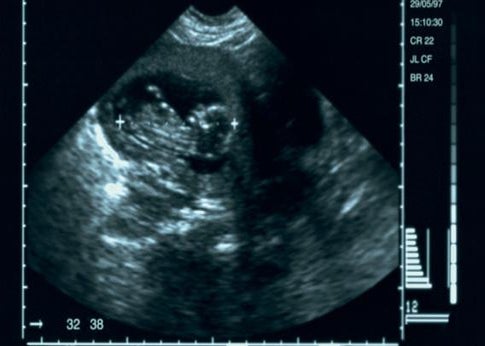What Percent Of Women Seeking An Abortion Change Their Mind
Does Looking at the Ultrasound Before an Abortion Change Women'southward Minds?

Photo past Stockbyte
The journal Obstetrics & Gynecology published an important study this month: the deepest inquiry yet into whether viewing ultrasound images can influence a woman'south decision to have an ballgame. True, anti-choicers have lately shifted tactics from business organization for the fetus to feigned business organization for women's health. Just they've succeeded in getting mandatory ultrasound laws on the books in ten states, and many keep to promote the thought that, when a woman glimpses her niggling bean during a sonogram, her maternal instinct awakens and prompts her to bear the pregnancy to term.
Where did this notion come from? In 1983, two doctors wrote an editorial noting that the grainy photos hastened fetal bonding for a pair of female person patients who wanted to requite birth. They speculated that the aforementioned bonding might happen fifty-fifty to women who didn't want to requite birth. Over iii decades of conservative telephone (and a few dubious studies funded by abortion crisis centers), this wisp of conjecture permutated: By 2013, pundits like Rachel Campos-Duffy were claiming that more than 90 percent of women alter their mind about ballgame after viewing an ultrasound.
Seven states now mandate that women seeking abortion get an ultrasound starting time and crave doctors offer the women a chance to run into the images; three states require the doctors to prove and describe the ultrasound. But despite the conservative push for these laws, smaller studies out of Texas, Canada, and S Africa imply that sonogram viewings do not impact women's decisions to terminate or continue their pregnancies.
This latest study is much larger. Researchers analyzed 15,575 medical records from an urban ballgame care provider in Los Angeles. Each patient seeking an ballgame was asked how she felt virtually her choice: Those who fabricated "clear and confident" replies were rated as having "loftier decision certainty," while those who seemed sad, aroused, or clashing were said to show "medium" or "low" decision certainty. (But vii.4 percent of the women fell into the latter categories.) Patients underwent ultrasounds equally office of the standard procedure, and 42.five percent of them opted to see the images. Of those, 98.4 percent terminated their pregnancies; 99 per centum of the women who did not look at the photographs concluded their pregnancies. Just here's the thing: The women who viewed the sonograms and then backed out were all part of that 7.four percent of women with low or medium determination certainty. Women who knew ballgame was the correct determination for them connected with the procedure whether they were shown the images or not.
The master takeaway here is definitely that 98.iv percent of the women who saw their ultrasounds went on to become an abortion anyway. And for the 1.half-dozen percent who decided not to go through with it, other factors, such as gestational age, were more salient in swaying them. ("It is the information the ultrasound browse renders … rather than the image that influences women'due south decision-making," the researchers write.) Too, it is articulate that one time you've resolved to terminate, gazing at the bean won't alter that: Exactly none of the women with loftier decision certainty were dissuaded by their sonograms.
Yet viewing the ultrasound images did influence some of the wavering women to stick with their pregnancies. Fifty-fifty though the number is very small, this is important to acknowledge. Information technology means not only that forcing or pressuring women to look at their fetus will probably forbid a sliver of abortions—which is relevant for those who oppose and want to reduce abortions—simply also that some women do answer to these pictures. I don't buy the patronizing notion that patients seeking abortion "know not what they do"—that they accept some false idea almost the contents of their uteruses to be toppled by an "adorable," "precious" or "lifelike" sonogram. I too doubtfulness all women even have the maternal instinct right-wingers hope these images will fan to life. But I practice trust that unsure women who voluntarily await at ultrasounds and and so determine against abortion are interim as rationally every bit the ones who determine to go through with it. We all make choices along a diverseness of axes: the financial axis; the relationship-status centrality; the personal goals and dreams axis; the ethical axis; and, yes, the emotional centrality. Expecting women to ignore any ane flake of data (as if they are not capable of weighing it, carefully, aslope the others) is underestimating women.
Of form, few pro-choicers would dream of denying a adult female considering abortion the opportunity to peruse her ultrasound, if she wanted to. And given that only 42.5 percent of the women in the report really wanted to, it is 100 percent clear that sonogram-viewing shouldn't exist mandatory. The researchers warn of the slight drop in abortions amidst women who saw their sonograms that, "these results cannot be generalized to women'south feel of ultrasound viewing in settings where it is required." What is for sure is that "patient satisfaction and health outcomes … are enhanced when patients feel control over decisions related to their intendance." Which ways forcing a woman to stare at her fetus earlier terminating information technology remains very much in violation of that new conservative golden standard, "women'south wellness."
What Percent Of Women Seeking An Abortion Change Their Mind,
Source: https://slate.com/human-interest/2014/01/ultrasound-viewing-before-an-abortion-a-new-study-finds-that-for-a-small-percentage-of-women-sonograms-change-minds.html
Posted by: warrenexhaf1942.blogspot.com


0 Response to "What Percent Of Women Seeking An Abortion Change Their Mind"
Post a Comment